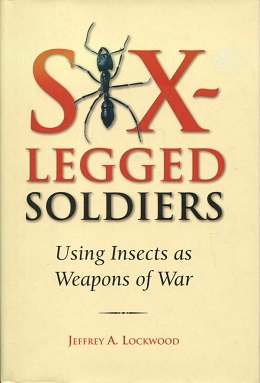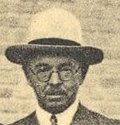Related Research Articles

The Pentatomoidea are a superfamily of insects in the Heteroptera suborder of the Hemiptera order. As Hemiptera, they share a common arrangement of sucking mouthparts. The roughly 7000 species under Pentatomoidea are divided into 21 families. Among these are the stink bugs and shield bugs, jewel bugs, giant shield bugs, and burrower bugs.

The Rocky Mountain locust is an extinct species of grasshopper that ranged through the western half of the United States and some western portions of Canada with large numbers seen until the end of the 19th century. Sightings often placed their swarms in numbers far larger than any other locust species, with one famous sighting in 1875 estimated at 198,000 square miles (510,000 km2) in size, weighing 27.5 million tons and consisting of some 12.5 trillion insects, the greatest concentration of animals ever speculatively guessed, according to Guinness World Records.

Grasshoppers are a group of insects belonging to the suborder Caelifera. They are among what is possibly the most ancient living group of chewing herbivorous insects, dating back to the early Triassic around 250 million years ago.
Entomological warfare (EW) is a type of biological warfare that uses insects to interrupt supply lines by damaging crops, or to directly harm enemy combatants and civilian populations. There have been several programs which have attempted to institute this methodology; however, there has been limited application of entomological warfare against military or civilian targets, Japan being the only state known to have verifiably implemented the method against another state, namely the Chinese during World War II. However, EW was used more widely in antiquity, in order to repel sieges or cause economic harm to states. Research into EW was conducted during both World War II and the Cold War by numerous states such as the Soviet Union, United States, Germany and Canada. There have also been suggestions that it could be implemented by non-state actors in a form of bioterrorism. Under the Biological and Toxic Weapons Convention of 1972, use of insects to administer agents or toxins for hostile purposes is deemed to be against international law.

Six-Legged Soldiers: Using Insects as Weapons of War is a nonfiction scientific warfare book written by author and University of Wyoming professor, Jeffrey A. Lockwood. Published in 2008 by Oxford University Press, the book explores the history of bioterrorism, entomological warfare, biological warfare, and the prevention of agro-terrorism from the earliest times to modern threats. Lockwood, an entomologist, preceded this book with Ethical issues in biological control (1997) and Locust: The devastating rise and mysterious disappearance of the insect that shaped the American frontier (2004), among others.
Daniel Otte is a noted behavior ecologist, a world expert on crickets and grasshoppers and a prominent scientific illustrator. He has made significant contributions to evolutionary biology. He is curator and chairman of the Department of Entomology at the Academy of Natural Sciences in Philadelphia.

The Fauna of Saskatchewan include several diverse land and aquatic animal species. From the multiplicity of invertebrates and vertebrates, two have been chosen as symbols of Saskatchewan. Cenozoic vertebrate fossils reveal the geological evolution of the interior plains and its prehistoric biogeography. Today, Saskatchewan's ecosystems range from the sub-arctic tundra of the Canadian Shield in north Saskatchewan to aspen parkland, the Mid-Continental Canadian forests in the centre of the province and grassland prairie. Fauna inhabit areas unique to their own specific and varied breeding, foraging and nesting requirements. With a large land and water area, and small population density, the ecoregions of Saskatchewan provide important habitat for many animals, both endangered and not. Naturalists observing wildlife have enumerated shrinking and growing wildlife populations. They advocate programs and methods to preserve or re-introduce endangered species and identify programs of control for outbreaks of wildlife populations. A broad diversity of wildlife habitats are preserved as parks and reserves protecting the feeding and breeding grounds of protected and indigenous fauna of Saskatchewan.

Insects are pancrustacean hexapod invertebrates of the class Insecta. They are the largest group within the arthropod phylum. Insects have a chitinous exoskeleton, a three-part body, three pairs of jointed legs, compound eyes and one pair of antennae. Their blood is not totally contained in vessels; some circulates in an open cavity known as the haemocoel. Insects are the most diverse group of animals; they include more than a million described species and represent more than half of all known living organisms. The total number of extant species is estimated at between six and ten million; potentially over 90% of the animal life forms on Earth are insects.

Sir Boris Petrovitch Uvarov was a Russian-British entomologist best known for his work on the biology and ecology of locusts. He has been called the father of acridology.
Jay R Traver was a University of Massachusetts entomologist who studied and published about mayflies. She described over 200 new species and contributed to the reorganization of the systematics of the entire order. She has been called "the first Ephemeroptera specialist in North America".
Melanoplus chiricahuae, the Chiricahua short-wing grasshopper, is a species of spur-throated grasshopper in the family Acrididae. It is found in North America.
Melanoplus stonei, known generally as the Stone's grasshopper or Stone's locust, is a species of spur-throated grasshopper in the family Acrididae. It is found in North America.
Melanoplus militaris, the military spur-throat grasshopper, is a species of spur-throated grasshopper in the family Acrididae. It is found in North America.

Melanoplus frigidus, known generally as the Nordic mountain grasshopper or narrow-winged locust, is a species of spur-throated grasshopper in the family Acrididae. It is found in Europe and Northern Asia.
The Wyoming House For Historic Women, also known as Wyoming Women's History House is a museum in downtown Laramie, Wyoming, United States, which celebrates the achievements of 13 women from the state of Wyoming. It was established by the Louisa Swain Foundation, which honors Louisa Swain, the first woman in the United States to vote in a general election. She cast her ballot on September 6, 1870, in Laramie, Wyoming. The museum opened in 2012. The Wyoming State Historical Society says Swain was "the first woman in the world to cast a ballot under laws giving women and men equal voting rights".

Monteithiella humeralis, commonly known as the pittosporum shield bug is a species of herbivorous shield bug native to Australia and introduced in New Zealand. As its common name suggests, it is most commonly observed feeding on Pittosporum plants.
Judith A. Marshall is an entomologist in the UK. She is an expert in grasshoppers, crickets and related insects (Orthoptera) and is emeritus Curator of Entomology at the Natural History Museum, London.
References
- ↑ "Prairie Soul Finding Grace in the Earth Beneath My Feet". uua.org. April 5, 2007. Archived from the original on January 14, 2009. Retrieved 2009-01-05.
- 1 2 "Jeff Lockwood to Read from His New Book". uwyo.edu. October 10, 2008. Archived from the original on June 17, 2011. Retrieved 2009-01-05.
- ↑ "Brown Award Winners". nmt.edu. Archived from the original on July 4, 2008. Retrieved 2009-01-05.
- ↑ Lockwood, Jeffrey Alan (1985). The behavioral ecology of the first instar southern green stink bug, Nezara viridula (L.). OCLC 15135366 – via OCLC 15135366.
- ↑ Lockwood, Jeffrey Alan; Alexandre V. Latchininsky; Mikhail Georgievich Sergeev (2000). Grasshoppers and Grassland Health. Springer. ISBN 0-7923-6529-1.
- ↑ "Jeffrey A. Lockwood". uuworld.org. Retrieved 2009-01-05.